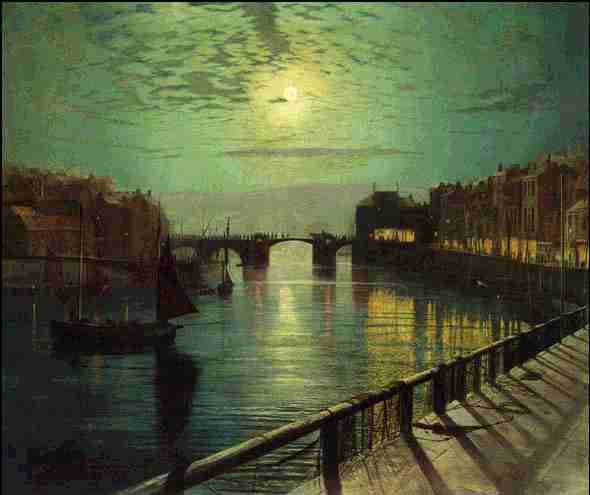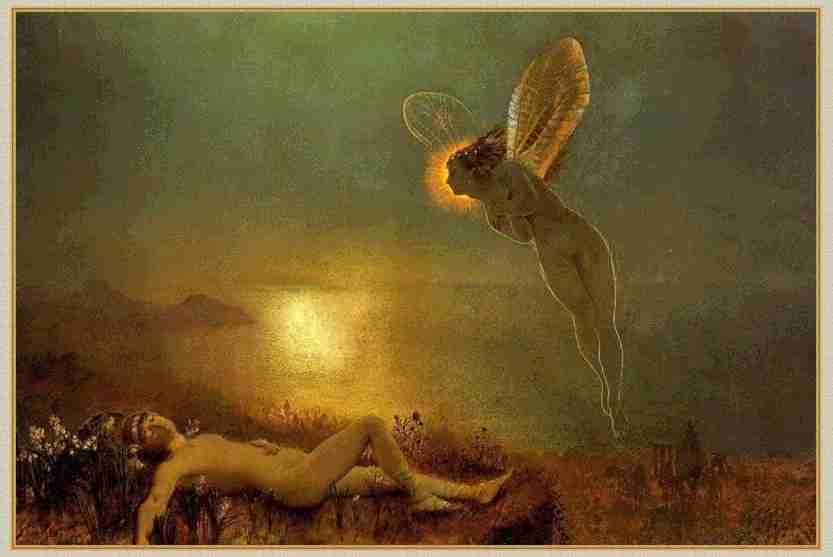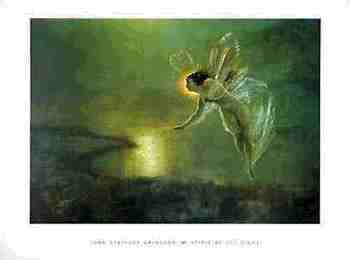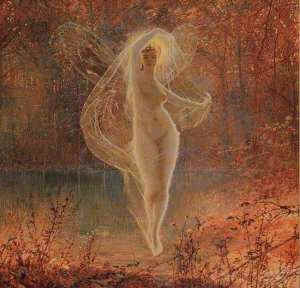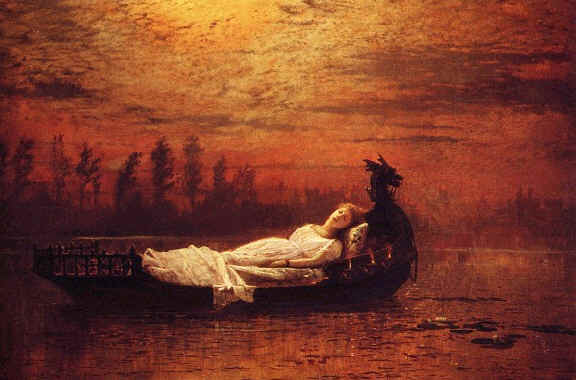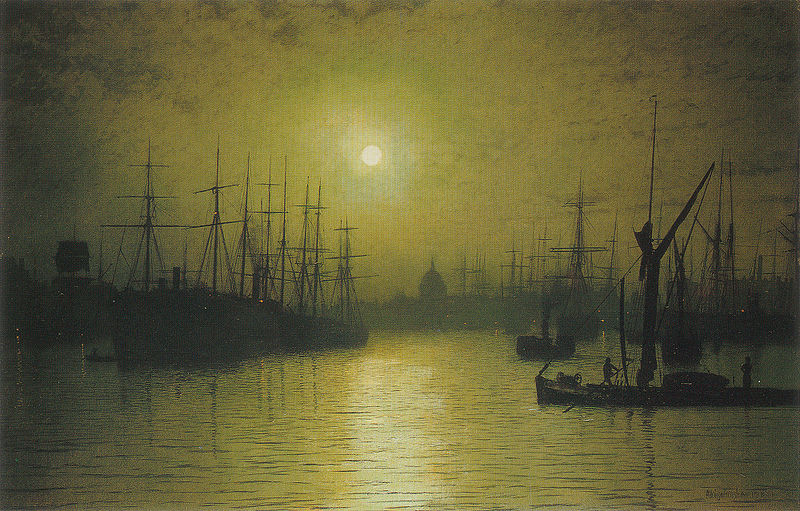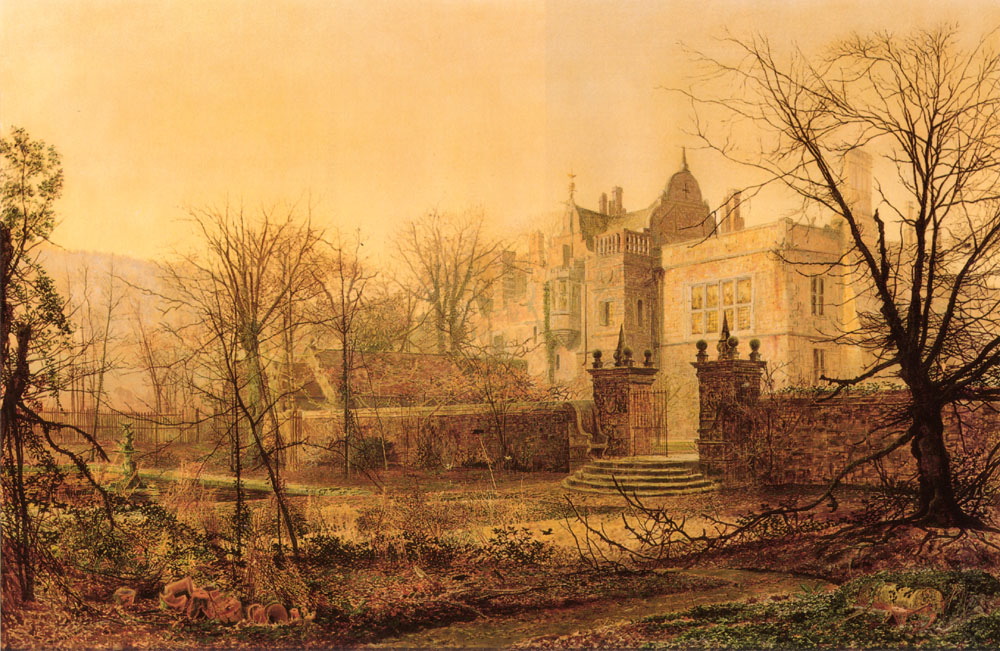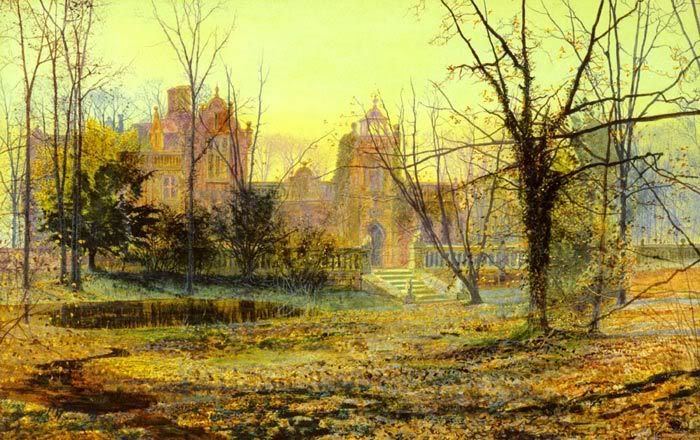Atkinson Grimshaw, Victorian Painter
of Ethereal Scenes and Fairy Figures

Atkinson Grimshaw in His 30’s.
John Atkinson Grimshaw was a noted painter in the mid to late 1800s whose subject matter was primarily fairy figures, landscapes, and dockland areas, particularly at sunset and by moonlight. He was born in Leeds in 1836 and began painting full-time about 1861; he dropped his first name by about 1867. He is descended from the Edward and Dorothy (Raner) Grimshaw line of Yorkshire.
Contents
Photograph of Atkinson Grimshaw
Samples of Atkinson Grimshaws Artwork
Wikipedia Entry on Atkinson Grimshaw
Biographies of Atkinson Grimshaw
Ancestor and Descendant Chart for Atkinson Grimshaw
Paintings and Photos from the Worldwide Web
Curious Story about Artwork of Atkinsons Son, Louis Grimshaw
Webpage Credits
Thanks go to Terry Micks for providing the website biographies and to Margaret Dequine for contributing the piece on the lost artwork by Atkinsons son, Louis, as described below. Thanks also to Mary Ferriss for providing rich detail on some of Atkinson Grimshaw’s descendants and a number of photos relevant to his life.
Photographs of Atkinson Grimshaw
Photos of Atkinson Grimshaw and his wife, Theodosia Hubbarde, are shown below.
Title: Carte de Visite of John Atkinson Grimshaw
Artist: British Photographer
Product code: LMG394625
Edition type: Open edition
Publisher: Bridgeman Art Library
Copyright: © Bridgeman Art Library / Leeds Museums and Galleries (City Art Gallery) U.
Source: http://www.magnoliabox.com/art/381857/Carte_de_Visite_of_John_Atkinson_Grimshaw
Title: John Atkinson Grimshaw and Theodosia Grimshaw
Artist: British Photographer
Product code: LMG394626
Edition type: Open edition
Publisher: Bridgeman Art Library
Copyright: © Bridgeman Art Library / Leeds Museums and Galleries (City Art Gallery) U.K.
Source: http://www.magnoliabox.com/art/381858/John_Atkinson_Grimshaw_and_Theodosia_Grimshaw
Samples of Atkinson Grimshaws Artwork
Two contributors to YouTube have posted samples of Atkinson Grimshaw’s paintings. They can be found at the following addresses:
In addition, most of Atkinson Grimshaws artwork can be found on various websites that feature his paintings as posters that can be purchased. A few examples are provided below to give a sense of Atkinsons art. The webpages where the images were obtained are indicated in parentheses.
Tranquility (http://www.magnoliabox.com/art/103742/Tranquility)
Whitbey Harbor by Moonlight (1867) [http://www.spartacus.schoolnet.co.uk/Jgrimshaw.htm]
Endymion on Mount Latmos (1879) [http://www.artinaclick.com]
Midsummer Night [http://www.allposters.com]
Spirit of the Night [http://www.allposters.com]
Autumn [http://www.allposters.com]
Elaine [http://www.artinaclick.com]
Wikipedia Entry on Atkinson Grimshaw
The following article and images were obtained from Wikipedia.
John Atkinson Grimshaw
From Wikipedia, the free encyclopedia
John Atkinson Grimshaw (6 September 1836 – 13 October 1893) was a Victorian-era artist, a “remarkable and imaginative painter”[1] known for his city scenes and landscapes.[2][3]
His early paintings were signed “JAG,” “J. A. Grimshaw,” or “John Atkinson Grimshaw,” though he finally settled on “Atkinson Grimshaw.”
He was born 6 September 1836 in Leeds. In 1856 he married his cousin Frances Hubbard (1835-1917). In 1861, at the age of 24, to the dismay of his parents, he departed from his first job as a clerk for the Great Northern Railway to pursue a career in art. He began exhibiting in 1862, under the patronage of the Leeds Philosophical and Literary Society, with paintings mainly of birds, fruit, and blossoms.[4] He became particularly successful in the 1870s and was able to afford to rent a second home in Scarborough, which also became a favourite subject.
Work

Nightfall on the Thames, 1880
Grimshaw’s primary influence was the Pre-Raphaelites. True to the Pre-Raphaelite style, he put forth landscapes of accurate color and lighting, and vivid detail. He often painted landscapes that typified seasons or a type of weather; city and suburban street scenes and moonlit views of the docks in London, Leeds, Liverpool, and Glasgow also figured largely in his art. By applying his skill in lighting effects, and unusually careful attention to detail, he was often capable of intricately describing a scene, while strongly conveying its mood. His “paintings of dampened gas-lit streets and misty waterfronts conveyed an eerie warmth as well as alienation in the urban scene.”[5]
Dulce Domum (1855), on whose reverse Grimshaw wrote, “mostly painted under great difficulties,” captures the music portrayed in the piano player, entices the eye to meander through the richly decorated room, and to consider the still and silent young lady who is meanwhile listening. Grimshaw painted more interior scenes, especially in the 1870s, when he worked until the influence of James Tissot and the Aesthetic Movement.[6]
On Hampstead Hill is considered one of Grimshaw’s finest, exemplifying his skill with a variety of light sources, in capturing the mood of the passing of twilight into the onset of night. In his later career this use of twilight, and urban scenes under yellow light were highly popular, especially with his middle-class patrons.[7]
His later work included imagined scenes from the Greek and Roman empires, and he also painted literary subjects from Longfellow and Tennyson — pictures including Elaine and The Lady of Shalott. (Grimshaw named all of his children after characters in Tennyson’s poems.)[8]
In the 1880s, Grimshaw maintained a London studio in Chelsea, not far from the comparable facility of James Abbott McNeill Whistler. After visiting Grimshaw, Whistler remarked that “I considered myself the inventor of Nocturnes until I saw Grimmy’s moonlit pictures.”[9] Unlike Whistler’s Impressionistic night scenes, however, Grimshaw worked in a realistic vein: “sharply focused, almost photographic,” his pictures innovated in applying the tradition of rural moonlight images to the Victorian city, recording “the rain and mist, the puddles and smoky fog of late Victorian industrial England with great poetry.”[10]

Shipping on the Clyde, 1881
Grimshaw’s paintings depicted the modern world but managed to escape the depressing, dirty reality of industrial towns. Shipping on the Clyde for instance, a depiction of Glasgow’s Victorian docks, is a lyrically beautiful evocation of the industrial era. Grimshaw transcribed the fog and mist so accurately as to capture the chill in the damp air, and the moisture penetrating the heavy clothes of the few figures awake in the misty early morning.
Some artists of Grimshaw’s period, both famous and obscure, generated rich documentary records; Vincent Van Gogh and James Smetham are good examples. Others, like Edward Pritchett, left nothing. Grimshaw left behind him no letters, journals, or papers; scholars and critics have little material on which to base their understanding of his life and career.
Grimshaw died 13 October 1893, and is buried in Woodhouse cemetery, Leeds. His reputation rested, and his legacy is probably based on, his townscapes. The second half of the twentieth century saw a major revival of interest in Grimshaw’s work, with several important exhibits of his canon.
References
1. Christopher Wood, Victorian Painting, Boston, Little, Brown & Co., 1999; p. 173.
2. Alexander Robertson, Atkinson Grimshaw, London, Phaidon Press, 1996.
3. H. J. Dyos and Michael Wolff, eds., The Victorian City: Images and Realities, 2 Volumes, London, Routledge, 1973.
4. Isabella Steer, The History of British Art, Bath: Parragon, 2002; p. 154. ISBN 0-75257-602-X
5. Philip J. Waller, Town, City, and Nation, Oxford, Oxford University Press, 1983; p. 99.
6. Wood, pp. 264-5.
7. Steer, p. 154.
8. Wood, p. 172.
9. Lionel Lambourne, Victorian Painting, London, Phaidon Press, 1999; p. 112.
10. Lambourne, pp. 112-13.
External links
Wikimedia Commons has media related to: John Atkinson Grimshaw
Atkinson Grimshaw
A collection of Grimshaw paintings
Royal Academy biography
www.JohnAtkinsonGrimshaw.org 85 works by John Atkinson Grimshaw
Shipping on the Clyde in Glasgow from Grimshaw, in YOUR CITY AT THE THYSSEN, a Thyssen Museum’s project on Flickr
www.artcyclopedia.com
Phryne’s list of paintings by Grimshaw in accessible collections in the UK
Biographies of Atkinson Grimshaw
An excellent biography of Atkinson has been published by Robertson1. The publisher provides the following notes on this biography:
In this first comprehensive study of the artist, now issued in paperback, Robertson shows the full scope of Grimshaw’s work – from the early landscapes of the Lake District and Yorkshire to the townscapes, dockscenes, coastal views and richly colourful portrayals of sophisticated Victorian ladies. The author discusses the techniques of Grimshaw’s art, and examines the many varieties of colour and mood that are captured in his paintings. He also assesses Grimshaw’s place in Victorian art and society, comparing him with such contemporaries as James Tissot and Sir Lawrence Alma-Tadema. Many of Grimshaw’s paintings are in private collections and are here reproduced for the first time, ensuring the book’s appeal, not only to art lovers and general readers interested in Victorian art, but also to dealers and collectors. An appendix lists all the public collections which hold examples of the artist’s work.
In addition, three webpages provide biographies of Atkinson Grimshaw. Thanks to Terry Micks for finding and providing these webpage references. The three biographical renditions are included because they present different aspects or facts of Atkinson life.
http://www.artmagick.com/artists/grimshaw1.asp:
John Atkinson Grimshaw was a Leeds painter of landscapes, town views and dockyards, especially at sunset or by moonlight. Born the son of an ex-policeman, Grimshaw first began painting while working as a clerk for the Great Northern Railway. He encountered bitter opposition from his parents, but after his marriage in 1858 to Theodosia Hobbarde, a cousin of T.S. Cooper, he was able to devote himself to painting. By 1870, he was successful enough to rent Knostrop Old Hall, a 17th century mansion near Temple Newsam, which features in many of his pictures. Later in the 70s, he built a house near Scarborough, and in the 80s rented a studio in Chelsea. Grimshaw painted mostly for private patrons, and exhibited only 5 works at the Royal Academy between 1874 and 1886, and one at the Grosvenor Gallery. The towns and docks that he painted most frequently were Glasgow, Liverpool, Leeds’s, Scarborough, Whitby and London. Grimshaw’s style and subject matter changed little during his career; he strove constantly to perfect his own very individual vision. He was interested in photography, and sometimes used a camera obscure to project outlines on to canvas, enabling him to repeat compositions several times. He also mixed sand and other ingredients with his paint to get the effects he wanted. Although he established no school, Grimshaw’s pictures were forged and imitated in his lifetime, notably by Wilfred Jenkins and H. Meegan. Although his moonlit town views are his most popular works, he also painted landscapes, portraits, interiors, fairy pictures and neo-classical subjects. During his early period he signed “J.A. Grimshaw” but c.1867 dropped the John, and signed himself Atkinson Grimshaw. He usually signed his pictures on the front and the reverse, inscribed with the title. Two of his sons, Arthur and Louis, were also painters
Recommended Reading
Victorian Painting
by Christopher Wood
Atkinson Grimshaw by Sandra K Payne
Atkinson Grimshaw by Alexander Robertson
A Companion to Victorian and Edwardian Artists by Adrian Vincent
Strange and Secret Peoples : Fairies and Victorian Consciousness
The Illustrated Encyclopaedia of Arthurian Legends by Ronan Coghlan
Victorian Fairy Painting by Jeremy Maas
A Small Book of Fairies by Eugene Stiles
Fairies: Boxed Notecards From the Deep Waters : Maidens of Myth and Mystery by Toshiyuki Takamiya
Treasures of British Art: Tate Gallery (Tiny Folio Series) by Robert Upstone/Nicholas Serota
http://www.spartacus.schoolnet.co.uk/Jgrimshaw.htm
John Atkinson Grimshaw was born in Leeds in 1836. His father was a policeman but in 1848 he found work with the Great Northern Railway Company. Grimshaw’s parents were strict Baptists and his mother strongly disapproved of his interest in painting and on one occasion she destroyed all his paints.
In 1852 Grimshaw became a clerk at the Great Northern Railway office in Leeds. The city had several art galleries and Grimshaw was able to see the work of Holman Hunt (The Light of the World), Henry Wallis (Death of Chatterton), Rosa Bonheur (The Horse Fair) and William Powell Frith (Derby Day).
Grimshaw decided to become a full-time painter and in 1861 he left his job with the Great Northern Railway. Grimshaw’s paintings were sold in two art galleries, smaller picture dealers and a couple of bookshops in Leeds. One of his main customers was
Thomas Fenteman, who owned an antiquarian booksellers. Fenteman was a deeply religious man and would only buy the pictures after Grimshaw had confirmed that they had not been painted on a Sunday.
Grimshaw became a popular artist in Leeds and in 1865 he was able to move with his wife to a more expensive part of the city. William Agnew, a London art dealer, began purchasing his work. Further success came when a picture by Grimshaw was accepted by the Royal Academy. By 1870 Grimshaw was in a position to buy Knostrop Old Hall, a large seventeenth-century manor house, two miles from Leeds. Fanny Grimshaw gave birth to fifteen children but only six reached adulthood.
Until the early 1870s Grimshaw’s paintings were predominantly still lifes with a few landscapes of the Leeds area. However, he gradually became interested in painting night scenes. This included Liverpool from Wapping (1875), Nightfall down the Thames (1880), Shipping on the Clyde (1881), Park Row, Leeds (1882), The Thames by Moonlight (1884), Liverpool Quay by Moonlight (1887) and Prince’s Dock, Hull (1887). These paintings often included the smoke pollution and damp fogs that were common in industrial cities in the late 19th century.
Grimshaw had campaigned for a Leeds City Art Gallery since it was first suggested by Edmund Bates in 1862, and after a long struggle it was eventually opened in 1888. The Gallery mounted annual spring exhibitions in which Grimshaw was always represented. John Atkinson Grimshaw died in 31st October 1893.
http://www.xrefer.com/entry/438500
He was born in Leeds, the son of a policeman. After working as a clerk for the Great North Railway, he turned to painting, against his parents’ wishes. He worked mainly in Leeds and in the North of England, where he gained a reputation for his romantic moonlight portrayals of towns and ports (e.g. Liverpool Quay by Moonlight, 1887, London, Tate Gallery). He was popular, despite rarely exhibiting at the Royal Academy. His work was precise and highly finished, using strong, luminous colour. Although he is best known for night scenes, some of his best works were daytime landscapes which showed a Pre-Raphaelite interest in detailed foliage (e.g. Autumn Glory Old Mill, 1869, Leeds). He also experimented with literary and historical subjects (e.g. Elaine, 1877, private collection). His sons, Arthur (1868-1913) and Louis (1870-1943) imitated his style.
Ancestor and Descendant Chart for Atkinson Grimshaw
Atkinson Grimshaw was descended from the Edward and Dorothy (Raner) Grimshaw line – a portion of their descendant chart, down through Atkinson and his descendants, is shown below. A description of the Edward and Dorothy Grimshaw line, including a more complete descendant chart, is given on a companion webpage. Mary Ferriss has provided much additional information on some of Atkinson’s descendants, who are shown in italics in the descendant chart. Atkinson married Francis Hubbarde and there were 15 children in the family, although some did not survive to adulthood.
Edward Grimshaw* 1559 – 1635 + Esibell Collier
Edward Grimshaw* (About 1559 – 22 Jun 1635) & Dorotye Raner
|–William Grimshaw
|–Abraham Grimshaw (1603 – 1670) & Sarah ( – 21 Sep 1695)
|–|–JeremyJeremiah Grimshaw* (21 Jul 1653 – 12 Aug 1721) & Mary Stockton ( – 6 Jan 1692/1693)
|–|–|–Joshua Grimshaw (12 Apr 1687 – 8 Jan 1764) & Jane Oddy (1686 – 1771)
|–|–|–|–John Grimshaw (5 Dec 1723 – ) & Hannah Fieldhouse
|–|–|–|–|–William Grimshaw* (1764 – 5 Sep 1829) & Ann Grainger (1768 – 1805)
|–|–|–|–|–|–Jonathan Grimshaw (20 Jul 1784 – ) & Sarah Pickersgill
|–|–|–|–|–|–|–David Grimshaw (11 Apr 1811 – ) & Mary Atkinson (About 1811 – 19 Apr 1889)
|–|–|–|–|–|–|–|–John Atkinson Grimshaw (6 Sep 1836 – 31 Oct 1893) & Francis Theodosia Hubbarde
|–|–|–|–|–|–|–|–|–Arthur Edmund Grimshaw (About 1865 – Jul 1913)
|–|–|–|–|–|–|–|–|–Lillian Josephine Theodosia Grimshaw (About 1866 – 18 Oct 1868)
|–|–|–|–|–|–|–|–|–Gertrude Grimshaw (About 1868 – 6 Oct 1874)
|–|–|–|–|–|–|–|–|–Louis Grimshaw (About 1870 – ) & Marion
|–|–|–|–|–|–|–|–|–Wilfred Atkinson Grimshaw (About 1871 – 15 Dec 1937) & Clara Ellen (About 1869 – 31 Aug 1957)
|–|–|–|–|–|–|–|–|–Hubert James Grimshaw (About 1873 – )
|–|–|–|–|–|–|–|–|–Clara Mary Grimshaw (27 Oct 1874 – )
|–|–|–|–|–|–|–|–|–Elaine C Grimshaw (1877 – 1965) & unknown Phillips
|–|–|–|–|–|–|–|–|–|–Marjory unknown (? – & unknown Johns
|–|–|–|–|–|–|–|–|–|–Guy Dibdin Ragland Phillips* (ca 1910 – 1988) & Jemima unknown (? – 1972)
|–|–|–|–|–|–|–|–|–|–|–Elaine Phillips
|–|–|–|–|–|–|–|–|–|–|–Margaret Phillips
|–|–|–|–|–|–|–|–|–|–|–Rosemary Phillips
|–|–|–|–|–|–|–|–|–|–Guy Dibdin Ragland Phillips (ca 1910 – 1988) & Ivy unknown
|–|–|–|–|–|–|–|–|–Lancelot G Grimshaw (1877 – ) & Hilda Jane Bentley (1881 – 1961)
|–|–|–|–|–|–|–|–|–|–Constance Mary Grimshaw (1923 – 1989) & William Edward Ferriss (1918 – 2009)
|–|–|–|–|–|–|–|–|–|–|–Susan Anne Ferriss (1958 – 1977) & Derek Jones. Married 1977
|–|–|–|–|–|–|–|–|–|–|–|–Alan Jones (1977 – )
|–|–|–|–|–|–|–|–|–|–|–Mary Elizabeth Ferriss (1961 ) & Michael John Brackley (1949 – 1997). Married 1995.
|–|–|–|–|–|–|–|–|–|–|–|–Gavin David Michael Brackley (1997 – )
|–|–|–|–|–|–|–|–|–|–|–|–Jessica Susan Ferriss (2002 = )
|–|–|–|–|–|–|–|–|–Enid Grimshaw
|–|–|–|–|–|–|–|–Jonathon Grimshaw (16 Feb 1841 – 6 Aug 1920) & Mary Clayton
Mary Ferriss has also provided details on members of the family in an email sent on January 5, 2011; excerpts from the email are shown below.
Regarding JAG’s children who survived to adulthood, Arthur was a musician and Enid was a singer.
There is an entry for my grandfather’s twin, Elaine C Grimshaw. She died in 1965.
Elaine had a daughter called Marjory who died in 1993 (I do not know when she was born). Her husband’s surname must have been Johns. I do not know if she had any children. I never heard about any.
Elaine’s son was Guy Dibdin Ragland Phillips who died aged 78 in 1988. He was a journalist, author and artist. There is a lot of information about him on the internet and his books are available at Amazon. He was married to Jemima (unknown maiden name), who died in 1972. They had 3 daughters, Elaine, Margaret and Rosemary. Guy remarried after his wife died and his new wife’s name was Ivy. I believe she has also died.
Lancelot Grimshaw (Elaine’s twin) was my grandfather. He was a press editor’s secretary, according to his marriage certificate, then a journalist when my Mum was born. Lancelot married Hilda Jane Bentley (1881-1961). Their only child, my mother Constance Mary Grimshaw, was born in 1923 and died in 1989. My mother married William Edward Ferriss (1918-2009) and they had 2 children, Susan Anne Ferriss (1958-1977) and me, Mary Elizabeth Ferriss (1961- ).
Susan married Derek Jones in 1977 and died the day after her son, Alan Jones, was born. Alan has not married and has no kids yet and is now 33.
I married Michael John Brackley (1949-1997) in 1995 and we had 1 son, Gavin David Michael Brackley, in 1997, who is now nearly 14. Michael died nearly 2 months after he was born in 1997. I also have a daughter, Jessica Susan Ferriss, born in 2002.
Paintings and Photos from the Worldwide Web
Atkinson Grimshaw and his family lived at Knostrop Hall near Leeds in the 1870s. Mary Ferriss has kindly provided a number of photos related to Atkinson Grimshaw at Knostrop Hall. A description of Knostrop from Wikipedia is provided below, followed by several paintings by Atkinson Grimshaw as well as photos from the Web.
Knowsthorpe
From Wikipedia, the free encyclopedia
Knowsthorpe, Knostrop or Knostropp is an area of Leeds, West Yorkshire, England, on the River Aire. The spelling “Knostrop” is predominantly used for the large water treatment works in the area. Atkinson Grimshaw painted Knostrop Cut, Leeds, Sunday Night, 1893.
Knostrop Hall was built in the 17th century by Adam Baynes, Member of Parliament for Leeds during the Commonwealth, whose family had lived in the district since the mid 16th century.[1] Atkinson Grimshaw lived at the hall in the 1870s, and it was demolished in 1960.[2]
References
1. “Knostrop Hall”. Leodis. Retrieved 2009-03-22.
2. “Entrance to Pleasaunce, Knostrop Hall”. Leodis. Retrieved 2009-03-22.
Shown below is a painting of Knostrop Hall by Atkinson Grimshaw, entitled “Knostrop Hall, Early Morning”.

Source: http://artmight.com/Artists/John-Atkinson-Grimshaw-1836-1893/Knostrop-Hall-Early-Morning-25481p.html
The “Pleasuance” of Knostrop Hall is shown below.

Source: http://www.leodis.org/display.aspx?resourceIdentifier=8214
Several pictures of Atkinson and his children at Knostrop Hall are shown below.
Source: http://prints.culturelabel.com/art/381859/John_Atkinson_Grimshaw_and_Elaine_Grimshaw_at_the_gates_of.
John Atkinson and Elaine Grimshaw at the Gates of Knostrop Hall
Lancelot and Elaine Grimshaw at Knostrop
Elaine and Lancelot Grimshaw on the Grounds of Knostrop
Several additional paintings of Knostrop Hall by Atkinson Grimshaw have been found on websites and are shown below.
“Knostrop Hall, Leeds”

Source: http://www.fineartprintsondemand.com/artists/grimshaw/knostrop_hall_leeds.htm
“Evening Knostrop Old Hall”

“In the Pleasuance, Knostrop Hall, Leeds 1875”

Source: http://www.magnoliabox.com/art/97884/In_the_Plesaunce_Knostrop_Hall_Leeds_1875
Curious Story about Artwork of Atkinsons Son, Louis Grimshaw
Thanks to Margaret Dequine for finding and providing the following webpage curiosity about a painting by Atkinsons son, Louis. The original publication cited in the webpage is unknown.
http://www.thisisbradford.co.uk/
Fortune that just hung on the wall
(First published on Thursday 14 May 1998)
Two paintings that hung for years on the wall of a Bradford house have netted their owner almost £50,000.
The father-of-two, in his 40s, inherited them from his mother and had no idea of their true value.
The Victorian paintings by Louis Grimshaw are both of Edinburgh streets – George Street and Princes Street, the city’s main thoroughfare.
The man, who wants to remain anonymous, first became aware of their worth when he had them valued by experts at Phillips the auctioneers.
Valuers at the Leeds office estimated each was worth £10,000 to £15,000. But at auction the pair fetched £48,300.
He was present for the frantic bidding when a London buyer snapped up both. “After the bidding he went back to work absolutely delighted,” said Phillips picture specialist Andre Zlattinger. “He is now planning a nice holiday.”
Grimshaw was a Leeds artist whose work has recently risen considerably in value.
He was part of a well-known painting dynasty made up of his father John Atkinson Grimshaw, brothers Wilfred and Arthur and sister Elaine. Mr Zlattinger said: “These two are very nice examples of his work.”
Because the Grimshaw family knew a lot of local people, they gave away quite a number to acquaintances, he added.
That could mean there are other Grimshaw paintings in Bradford that people are not aware of.
Mr Zlattinger said: “If people have any paintings that may be of interest, they can call in and we will provide a free verbal valuation.”
References
1Robertson, Alexander, 1996, Atkinson Grimshaw: Phaidon Press, 127 p., paperback
Webpage History
Webpage posted April 2001, updated September 2001. Webpage replaced due to broken banner, October 2007. Updated and reorganized December 2009, with addition of links to YouTube presentations of Atkinson Grimshaw’s work. Updated January 2011 with additions of descendant information and photos from Mary Ferriss.
